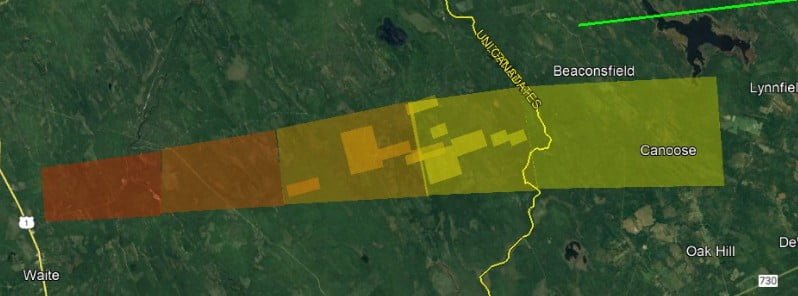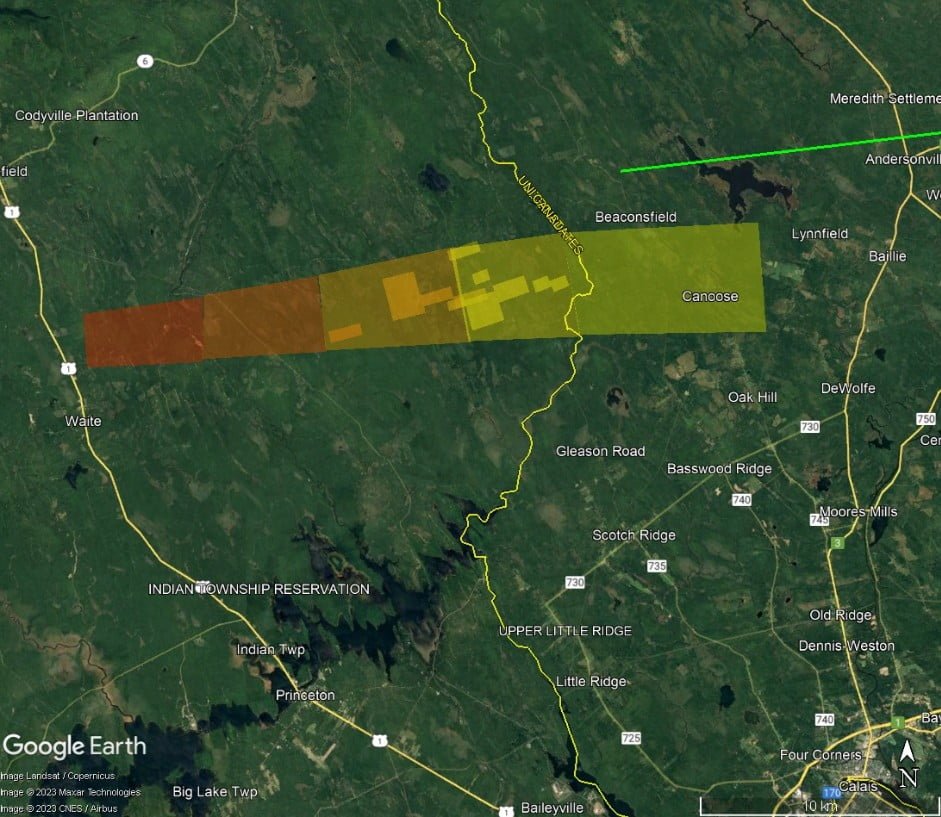Bright daylight fireball explodes over Maine – first radar-observed meteorite fall in the state, U.S.

A bright daylight fireball exploded over Maine, U.S. at 15:52 UTC (11:52 EDT) on April 8, 2023, causing loud sonic booms and lighting up the daytime sky. Four radar sweeps recorded signatures consistent with falling meteorites, making this the first radar-observed meteorite fall seen in Maine.
While the American Meteor Society (AMS) received only 6 reports, eyewitnesses said the fireball was bright even in midday, followed by loud sonic booms near Calais, Maine.
Signatures from falling meteorites were seen in data from a single NOAA NEXRAD radar (KCBW, Houlton, ME), NASA’s Astromaterials Research and Exploration Science (ARES) reported.1
Four radar sweeps recorded signatures consistent with falling meteorites, seen at the time and location reported by eyewitnesses.
The first appearance of falling meteorites occurred at 15:57:43.5 UTC at an altitude of 7.44 km (4.6 miles) above sea level. The last signature appeared at 16:02:23.7 UTC at 2.376 km (1.47 miles) a.s.l., for a total elapsed observation time of 4 minutes and 40 seconds.
This observation time is relatively short, but this is maybe because only one NEXRAD radar was within range of the fall.
Meteorite masses calculated from the radar signatures range from 1.59 to 322 g (0.056 – 11.4 ounces) although larger masses may have fallen.
Meteorites in this event fell directly into winds of up to about 160 km/h (100 mph), carrying smaller meteorites across the border into Canada.
This is the first radar-observed meteorite fall seen in Maine.

The Maine Mineral and Gem Museum, known for having the largest collection of meteorites from Mars and the moon on Earth, is offering a reward of $25,000 to anyone who finds a specific meteorite following the recent crash.2 The museum’s curator, Myles Felch, stated that to be eligible for the reward, the meteorite found must weigh at least 1 kg (2.2 pounds) and be confirmed to be genuine by analyzing its texture and chemistry.
The difficulty of finding the meteorite depends on several factors, including whether it was a witnessed fall, the composition of the meteorite, and the surface conditions of the fall site. Metallic meteorites are easier to identify in the field compared to stony ones, which can be more challenging for those who are inexperienced in identifying such objects. Previous falls have also shown that it is difficult to find meteorites in a forested area, which appears to be the case with this fall site.
References:
1 Waite, Maine meteorite event on April 8, 2023 – NASA/ARES
2 Bright ‘fireball’ flew over Maine and crashed, NASA says. Whoever finds it gets $25,000 – Miami Herald – April 12, 2023
Featured image: NASA/ARES

Commenting rules and guidelines
We value the thoughts and opinions of our readers and welcome healthy discussions on our website. In order to maintain a respectful and positive community, we ask that all commenters follow these rules.